
Vitilla is a popular variation of stickball played primarily in the Dominican Republic and areas in the United States with large Dominican populations. [1] [2]

Vitilla is a popular variation of stickball played primarily in the Dominican Republic and areas in the United States with large Dominican populations. [1] [2]
Overall rules and baserunning is roughly similar to basic forms of baseball, but there are only two bases in addition to home plate, only two or three fielders, a broomstick is used as a bat and a large plastic water bottle cap, called la vitilla, is used instead of a ball. The game also has aspects of Cricket, in that there are no walks or looking strike counts and strikeouts can be made by hitting a target behind the batter. The vitilla disk is difficult to hit, since it can float like a disk and can spin wildly at very high velocity, making for unpredictable fielding. The skill and coordination required in vitilla is credited with giving Dominican Major League Baseball players an advantage in hitting and fielding. [3] The game evolved from Dominican stickball in the 1970s, and had its first formal tournament in 2009. [4]
As a young street sport, there are no formal rules or governing sports authority to set rules. Beteyah, a company that makes vitilla equipment has suggested rules, [5] and another source of rules derives from the Red Bull Clasico De Vitilla tournaments. [3] Terminology is generally in Spanish, the primary language of most players.
Here is a list of ways vitilla differs from ordinary baseball: [6]
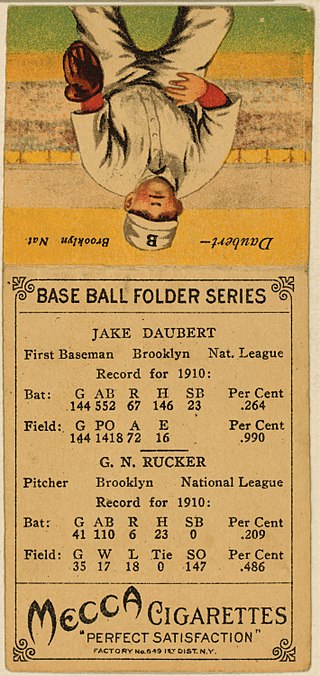
Baseball statistics include a variety of metrics used to evaluate player and team performance in the sport of baseball.
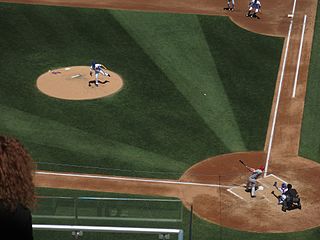
Baseball is a bat-and-ball sport played between two teams of nine players each, taking turns batting and fielding. The game occurs over the course of several plays, with each play generally beginning when a player on the fielding team, called the pitcher, throws a ball that a player on the batting team, called the batter, tries to hit with a bat. The objective of the offensive team is to hit the ball into the field of play, away from the other team's players, allowing its players to run the bases, having them advance counter-clockwise around four bases to score what are called "runs". The objective of the defensive team is to prevent batters from becoming runners, and to prevent runners advancing around the bases. A run is scored when a runner legally advances around the bases in order and touches home plate.

In baseball, a home run, homerun or homer is scored when the ball is hit in such a way that the batter is able to circle the bases and reach home plate safely in one play without any errors being committed by the defensive team. A home run is usually achieved by hitting the ball over the outfield fence between the foul poles without the ball touching the field.

Softball is a popular variation of baseball, the difference being that it is played with a larger ball, on a smaller field, and with only underhand pitches permitted. Softball is played competitively at club levels, the college level, and the professional level. The game was first created in 1887 in Chicago by George Hancock.
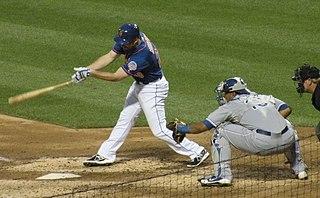
Catcher is a position in baseball and softball. When a batter takes their turn to hit, the catcher crouches behind home plate, in front of the (home) umpire, and receives the ball from the pitcher. In addition to this primary duty, the catcher is also called upon to master many other skills in order to field the position well. The role of the catcher is similar to that of the wicket-keeper in cricket.

In baseball, an intentional base on balls, usually referred to as an intentional walk and denoted in baseball scorekeeping by IBB, is a walk issued to a batter by a pitcher with the intent of removing the batter's opportunity to swing at the pitched ball. A pitch that is intentionally thrown far outside the strike zone for this purpose is referred to as an intentional ball.
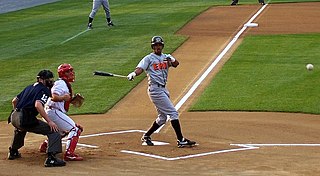
In baseball, a foul ball is a batted ball that:
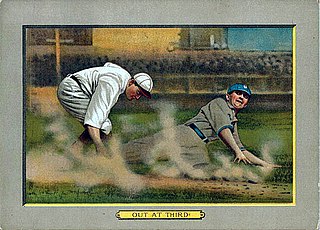
In baseball, an out occurs when the umpire rules a batter or baserunner out. When a batter or runner is out, they lose their ability to score a run and must return to the dugout until their next turn at bat. When three outs are recorded in a half-inning, the batting team's turn expires.
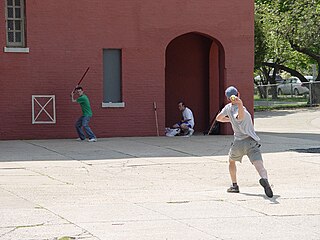
Stickball is a street game similar to baseball, usually formed as a pick-up game played in large cities in the Northeastern United States, especially New York City and Philadelphia. The equipment consists of a broom handle and a rubber ball, typically a spaldeen, pensy pinky, high bouncer or tennis ball. The rules come from baseball and are modified to fit the situation. For example, a manhole cover may be used as a base, or buildings for foul lines. The game is a variation of stick and ball games dating back to at least the 1750s. This game was widely popular among youths during the 20th century until the 1980s.
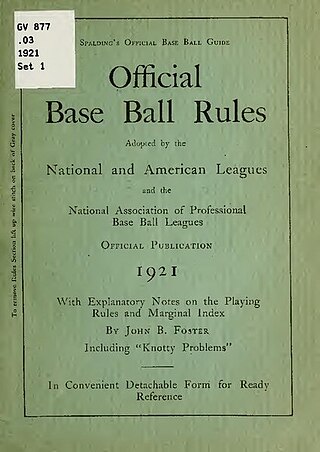
Throughout baseball's history, the rules have frequently changed as the game continues to evolve. A few typical rules most professional leagues have in common are that four balls are a base on balls, three strikes are a strikeout, and three outs end a half-inning.

A baseball field, also called a ball field or baseball diamond, is the field upon which the game of baseball is played. The term can also be used as a metonym for a baseball park. The term sandlot is sometimes used, although this usually refers to less organized venues for activities like sandlot ball.
Baseball and cricket are the best-known members of a family of related bat-and-ball games. Both have fields that are 400 feet (120 m) or more in diameter between their furthest endpoints, offensive players who can hit a thrown/"bowled" ball out of the field and run between safe areas to score runs (points) at the risk of being gotten out, and have a major game format lasting about 3 hours.

In the sports of baseball and softball, a batted ball is a pitch that has been contacted by the batter's bat. Batted balls are either fair or foul, and can be characterized as a fly ball, pop-up, line drive, or ground ball. In baseball, a foul ball counts as a strike against the batter, unless there are already two strikes on the batter, with special rules applying to foul tips and foul bunts. Fly balls are those hit in an arcing manner, with pop-ups being a subset of fly balls that do not travel far. Line drives are batted balls hit on a straight line trajectory, while ground balls are hit at a low trajectory, contact the ground shortly after being hit, and then either roll or bounce. Batted balls, especially line drives, can present a hazard to players, umpires, and spectators, as people have been seriously injured or killed after being struck by batted balls.

Pesäpallo is a fast-moving bat-and-ball sport that is often referred to as the national sport of Finland and has some presence in other places including Germany, Sweden, Switzerland, Australia, and Canada's northern Ontario. It is similar to brännboll, rounders, lapta, and baseball.
In baseball, the rules state that a batted ball is considered in flight when it has not yet touched any object other than a fielder or his equipment. Such a ball can be caught by a fielder to put the batter out.
The Knickerbocker Rules are a set of baseball rules formalized by William R. Wheaton and William H. Tucker of the Knickerbocker Base Ball Club in 1845. They have previously been considered to be the basis for the rules of the modern game, although this is disputed. The rules are informally known as the "New York style" of baseball, as opposed to other variants such as the "Massachusetts Game" and "Philadelphia town ball".
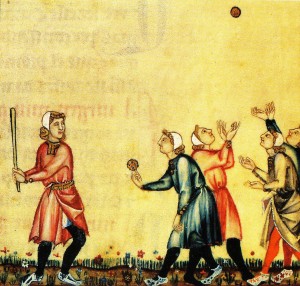
Bat-and-ball games, or safe haven games, are field games played by two opposing teams. Action starts when the defending team throws a ball at a dedicated player of the attacking team, who tries to hit it with a bat and then run between various safe areas in the field to score runs (points). The defending team can use the ball in various ways against the attacking team's players to force them off the field when they are not in safe zones, and thus prevent them from further scoring. The best known modern bat-and-ball games are cricket and baseball, with common roots in the 18th-century games played in England.
This is an alphabetical list of selected unofficial and specialized terms, phrases, and other jargon used in baseball, along with their definitions, including illustrative examples for many entries.

Corkball is a "mini-baseball" game featuring a 1.6-ounce (45 g) ball, which is stitched and resembles a miniature baseball. The bat has a barrel that measures 1.5 inches (3.8 cm) in diameter. Originally played on the streets and alleys of St. Louis, Missouri, as early as 1890, today the game has leagues formed around the country as a result of St. Louis servicemen introducing the game to their buddies and comrades during World War II and the Korean War. It has many of the features of baseball, yet can be played in a very small area because there is no base-running.

In sports, the term diamond sports refers to recreational variantsof baseball, a bat-and-ball sport. The most popular and closely related sport to baseball is softball, with the two sports being administered internationally by the World Baseball Softball Confederation (WBSC), alongside Baseball5.
{{cite web}}: CS1 maint: url-status (link){{cite web}}: CS1 maint: url-status (link)